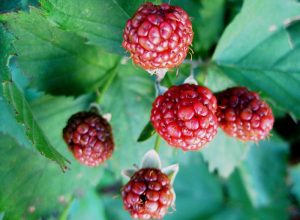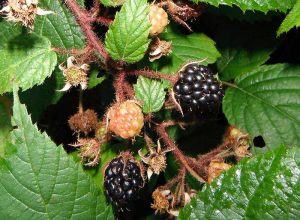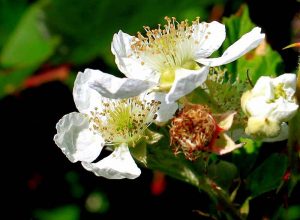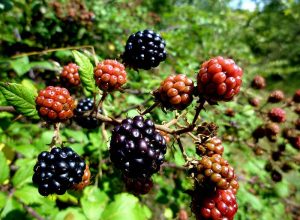Rovo – Rubus unifolius


Belonging to the same family as the raspberry, also the rovo, commonly called blackberry, we find will grow in any uncultivated soil, at the foot of a hedge, in a vegetable garden etc. With trunks and leaves covered in numerous robust hooked thorns it is considered equal to an infest.
From species which grow spontaneously, originally widespread in temperate zones of the continent, the breeders and botanists have selected diverse varieties, also slightly diverse amongst themselves.
These hybrids are shrubs with deciduous leaves, they are runners, with vigorous suckers that can reach 3 – 4 metres in length, very resistant to cold, they tolerate drought very well.
You can distinguish the three types by their deportment: erect, semi creeping and creeping or by the presence of at least the thorns, which if present are less annoying than those of of the wild plant.
Given its notable vigor, the denseness of the implant is very reduced: generally planted in a good substratum it will take up about 5 square metres, production can amount to 10kg per plant.
TERRAIN
It adapts to all types of soil, even if it is semi acid (5.5 / 6. ph), loose, fresh, and rich in organic substances will give a production of superior quality. The best fruit comes from plants which are exposed to full sun, but also if planted in semi shade the crop will be discreet.
FLORA AND FRUITS
At the top of the long suckers from the previous year and from the leaf pits from the lateral branches, numerous self pollinating flowers appear from May to June, united in bunches and light pink. After this the tasty fruit is formed with a pleasantly sour taste, first of all they are red, turning to shiny black when mature, and of a larger size than the wild fruit.
As with the raspberry, what we collect from the plant is the blackberry (see raspberry), that is a group of small single fruit (drupe) which when consolidated together we consider it to be the fruit.
Varieties of Rovo cultivated by PRANDINI’S GARDEN
- BLACK SATIN – Early
USE AND HEALTH GIVING PROPERTIES
With less contents of vitamins, sugar, mineral salts, and antioxidants
Compared to other summer fruit, nonetheless it has considerable amounts to offer, the fruit of the rovo is excellent if eaten freshly picked or in a tasty fruit salad, jams, ice creams, syrup and by the food industry as a colourant.
It lends well to being frozen. At the herbalist’s the leaves and roots can be used to make a herbal tea to settle the intestine.
POTTING PRUNING AND CULTIVATION
As the rovo is a very simple plant which needs little attention the raspberry. Potting consists of removing the suckers which have fruited in winter. If you leave on the stump, they will dry the following year and should be thinned from the suckers grown in the year.
Mulching with organic substances, dead leaves, grass cuttings, etc. it is advisable to avoid weeds growing around the stump. Keep it fresh with soil around it.
Watering is not necessary, but as the size of the fruit increases, in the case of drought it’s advisable to intervene for consistency, but not to excess, otherwise your fruit will be watery and tasteless.
Important to never shower water which could rot the fruit, but always to the base of the plant.
Parasite attacks are few and far between: as with the raspberry, high humidity could cause an attack of grey mould (Botrytis a specific virus transmitted by the Cicadellide.
The latter also called “Sputacchine” Spitters because of the similarity to saliva that the lava are wrapped in, together with the bollworm of the raspberry and a rare attack of yellow mite are the only parasites that can cause damage.
As most of these attacks are coincidental with the fruit maturing it is not possible to treat with an pesticide


